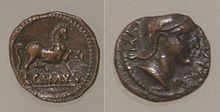
Quick Facts
Biography
Cunobeline (or Cunobelin, from Latin Cunobelinus, derived from Greek Kynobellinus, Κυνοβελλίνος) was a king in pre-Roman Britain from the late first century BC until the 40s AD. He is mentioned in passing by the classical historians Suetonius and Dio Cassius, and many coins bearing his inscription have been found. He appears to have controlled a substantial portion of south-eastern Britain, and is called "King of the Britons" (Britannorum rex) by Suetonius.
Cunobeline appears in British legend as Cynfelyn (Welsh), Kymbelinus (medieval Latin) or Cymbeline, as in the play by William Shakespeare. His name is a compound made up of cuno- (hound) and Belenos (the god Belenus).
History
From numismatic evidence Cunobelinus appears to have taken power around 9 AD, minting coins from both Camulodunum (Colchester, capital of the Trinovantes) and Verlamion (later the Roman town of Verulamium, now modern St Albans), capital of the Catuvellauni. Some of the Verulamium coins name him as the son of Tasciovanus, a previous king of the Catuvellauni; unlike his father's, his coins name no co-rulers. However his earliest issues are from Camulodunum, indicating that he took power there first, and some have a palm or laurel wreath design, a motif borrowed from the Romans indicating a military victory. He may have been emboldened to act against the Trinovantes by the Roman defeat in the Battle of the Teutoburg Forest in Germania in AD 9. The Trinovantes were a Roman ally whose independence was protected by a treaty made by Julius Caesar in 54 BC, but problems in Germania severely discouraged Augustus's territorial ambitions and ability to defend allies in Britain.
Cunobelinus appears to have maintained quite good relations with the Roman Empire. He used the title Rex (Latin "king") and classical motifs on his coins, and his reign saw an increase in trade with the continent. Archaeology shows an increase in luxury goods imported from the continent, including Italian wine and drinking vessels, olive oil and fish sauces from Hispania, glassware, jewellery and Gallo-Belgic tableware, which from their distribution appear to have entered Britain via the port of Camulodunum. He was probably one of the British kings that Strabo says sent embassies to Augustus. Strabo reports Rome's lucrative trade with Britain: the island's exports included grain, gold, silver, iron, hides, slaves and hunting dogs.

Cunobelinus had three sons, Adminius, Togodumnus and Caratacus, and a brother, Epaticcus, known to history. Epaticcus expanded his influence into the territory of the Atrebates in the early 20s AD, taking the Atrebatan capital Calleva (Silchester) by about 25. He continued to expand his territory until his death in about 35, when Caratacus took over from him and the Atrebates recovered some of their territory.
Adminius, judging by his coins, had control of Kent by this time. Suetonius tells us that in ca. 40 he was banished from Britain by his father and sought refuge with the emperor Caligula; Caligula treated this as if the entire island had submitted to him. Caligula prepared an invasion of Britain, but abandoned it in farcical circumstances, ordering his soldiers to attack the waves and gather seashells as the spoils of victory.
Cunobelinus died some time before 43. The Lexden Tumulus on the outskirts of Colchester has been suggested as his tomb (although the earlier Trinovantian king Addedomarus is another candidate for its occupant). Caratacus completed the conquest of the Atrebates, and their king, Verica, fled to Rome, providing the new emperor, Claudius, with a pretext for the conquest of Britain. Caratacus and Togodumnus led the initial resistance to the invasion. Dio Cassius tells us that the "Bodunni", a tribe who were tributary to the Catuvellauni, changed sides and supported the Romans. This is probably a misspelling of the Dobunni of Gloucestershire, indicating that Cunobelinus's hegemony extended as far as the West Country.
It is possible, based on epigraphic evidence, that Sallustius Lucullus, Roman governor of Britain in the late 1st century, was his grandson.
Legend and literature

Cunobelinus's memory was preserved in British legend and beyond. A genealogy preserved in the medieval Welsh manuscript Harleian 3859 contains three generations which read "Caratauc map Cinbelin map Teuhant". This is the equivalent of "Caratacus, son of Cunobelinus, son of Tasciovanus", putting the three historical figures in the correct order, although the wrong historical context, the degree of linguistic change suggesting a long period of oral transmission. The remainder of the genealogy contains the names of a sequence of Roman emperors, and two Welsh mythological figures, Guidgen (Gwydion) and Lou (Lleu).
In Geoffrey of Monmouth's Historia Regum Britanniae (1136) he appears as Kymbelinus, son of Tenvantius, a powerful warrior who was raised in the courts of Augustus. He was very friendly with the Roman court: his country was equipped with Roman weapons, and all tributes to Rome were paid out of respect, not out of requirement. He had two sons, Guiderius and Arvirargus. Guiderius succeeded him, but died in the early stages of Claudius's invasion, leaving Arvirargus to carry on the fight.
Geoffrey's story was incorporated into Raphael Holinshed's Chronicles in 1577, where it was found by William Shakespeare and used as the basis of his romance, Cymbeline. Beyond the name there is virtually nothing in common between the figure of Cymbeline and the historical Cunobelinus. The king, under the influence of his wicked second wife, forbids his daughter Imogen to marry Posthumus Leonatus, a low-born but worthy man, preferring that she marry his boorish stepson Cloten, leading to mistaken identity, jealousy caused by false accusations of infidelity and a war with Rome provoked by the withholding of tribute, again at the instigation of the queen. In the end peace between Britain and Rome is re-established, Cymbeline is reunited with his two sons, Guiderius and Arviragus, who were abducted in childhood by Belarius, a wrongly-banished nobleman. Imogen is reconciled with Posthumus. Cloten and his mother, the evil queen get their just deserts.
